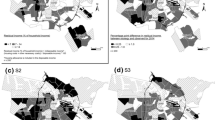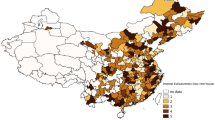Abstract
By increasing housing prices, land use regulations can have positive impacts among homeowners, but they can also have negative impacts on the availability of affordable housing. We examined heterogeneity in the price impacts of land use regulation across the conditional house price distribution; this heterogeneity may ameliorate or exacerbate the impacts of land use regulation on affordable housing. Our results suggest that the distribution of price impacts across the conditional house price distribution is relatively uniform. Results suggest that land use regulations both constrain housing supply and induce within housing market migration that spreads price impacts throughout the region.


Similar content being viewed by others
Notes
While Cunningham (2007) studied housing price volatility, the other two papers focused on the level of housing price.
Though most evidence comes from the USA due to data availability and significant variation in land use regulations across communities, evidence for similar relationships in England exists (Hilber and Vermeulen 2016).
The lagged variables included proportion of adults possessing a college degree, proportion of residents over the age of 55, proportion white, proportion black, proportion of households who owned their home and average household income.
Quigley et al. (2008) used preexisting measures of the political predisposition in each city as instruments. Saiz (2010) used religion and local government financial structure variables as instruments. Hilber and Vermeulen (2016) used exogenous variation from a policy reform, vote shares and historical density as instruments to identify the endogenous constraints—measures.
Communities are defined as a Census Place.
The classification of industries is based on the three digital Census industry codes.
The difference in sample sizes was small: 3.1 million houses (ACS 1% sample) and 3.25 million parcels (Zillow annual sample). Zillow’s sample included houses from all counties in the ACS sample with some additional counties as well. Zillow’s median sale price was slightly lower than ACS. The median house size across the two sources was identical, and ACS properties had a slightly older median age. (Median year built in the ACS sample was 1975 compared to 1982 for the Zillow sample.)
Coefficient estimates for block group characteristics should be interpreted with caution. A robust literature discusses the correspondence between these characteristics and other unmeasured local characteristics (Bayer et al. 2017; Beracha et al. 2016; Black 1999). For our purposes, these variables merely serve as a means of broadly controlling for local conditions in order to isolate the community fixed effect.
In each quantile, we failed to reject the null hypothesis that the specified endogenous regressor WRLURI can actually be treated as exogenous. The test statistic is distributed as chi-squared with degrees of freedom equal to the number of regressors tested. In this case, the degree of freedom is one. The test statistics for each sequential quantile with p value in parenthesis are as follows: 2.98 (0.08); 3.68 (0.06); 2.28 (0.13); 2.05 (0.15); 2.1 (0.15); 1.62 (0.2); 1.23 (0.27); 1.63 (0.2); 2.61 (0.11).
References
Andrews I, Stock J, Sun L (2018) Weak instruments in IV regression : theory and practice. Ann Rev Econ 1–29
Angrist JD, Lang K (2004) Does school integration generate peer effects? Evidence from Boston’s Metco Program. Am Econ Rev 94(5):1613–1634
Ashwood L, MacTavish K, Richardson D (2019) Legal enforcement of spatial and environmental injustice. In: Scott M, Gkarzios M, Gllent N (eds) The routledge companion to rural planning, 1st edn. Routledge, New York, NY
Bartik TJ (1991) Who benefits from state and local economic development policies?. Kalamazoo, MI: W.E. Upjohn Institute for Employment Research. https://doi.org/10.17848/9780585223940
Baum CF, Schaffer ME, Stillman S (2007) Enhanced routines for instrumental variables/generalized method of moments estimation and testing. Stata J 7(4):465–506
Bayer P, Casey M, Ferreira F, McMillan R (2017) Racial and ethnic price differentials in the housing market. J Urban Econ 102:91–105. https://doi.org/10.1016/j.jue.2017.07.004
Beracha E, Gilbert BT, Kjorstad T, Womack K (2016) On the relation between local amenities and house price dynamics. Real Estate Econ. https://doi.org/10.1111/1540-6229.12170
Black SE (1999) Do better schools matter? Parental valuation of elementary education. Q J Econ 114(2):577–599. https://doi.org/10.1162/003355399556070
Blanchard O, Katz LF (1992) Regional evolutions. Brookings Papers Econ Act 1:1–75
Cartwright AC (2016) Selective enforcement and rent extraction. Public Financ Manag 16(1):75–93
Chetverikov D, Larsen B, Palmer C (2016) IV quantile regression for group-level treatments, with an application to the distributional effects of trade. Econometrica 84(2):809–833. https://doi.org/10.3982/ECTA12121
Clapp JM, Ross SL (2004) Schools and housing markets: an examination of school segregation and performance in Connecticut. Econ J 114(499):425–440. https://doi.org/10.1111/j.1468-0297.2004.00253.x
Cun W, Pesaran MH (2018) Land use regulations, migration and rising house price dispersion in the U.S. Working Paper. https://doi.org/10.2139/ssrn.3162399
Cunningham CR (2007) Growth controls, real options, and land development. Rev Econ Stat 89(2):343–358
David H, Dorn D, Hanson GH (2013) The China syndrome: local labor market effects of import competition in the United States. Am Econ Rev 103(6):2121–2168
Diamond R (2016) The determinants and welfare implications of US Workers’ diverging location choices by skill: 1980–2000. Am Econ Rev 106(3):479–524. https://doi.org/10.1257/aer.20131706
Downs A (2002) Have housing prices risen faster in Portland than elsewhere? Housing Policy Debate 13(1):7
Fischel WA (2009) The homevoter hypothesis. Harvard University Press, Cambridge
Ganong P, Shoag D (2017) Why has regional income convergence in the U.S. declined? J Urban Econ 102:76–90. https://doi.org/10.1016/j.jue.2017.07.002
Gindelsky M, Wentland S (2018) Big data in housing : an overview of zillow microdata and its potential for national accounts. https://bea.gov/about/pdf/acm/2018/WENTLAND-Gindelsky-BigData-inHousing-5-18-18.pdf
Glaeser EL, Ward BA (2009) The causes and consequences of land use regulation: evidence from Greater Boston. J Urban Econ 65(3):265–278
Glaeser EL, Gyourko J, Saiz A (2008) Housing supply and housing bubbles. J Urban Econ 64(2):198–217. https://doi.org/10.1016/j.jue.2008.07.007
Goldsmith-pinkham P, Sorkin I, Swift H (2018) Bartik instruments: What, When, Why, and How∗. Unpublished, (March).
Gyourko J (2009) Housing supply. Annu Rev Econ 1(1):295–318
Gyourko J, Saiz A, Summers A (2008) A new measure of the local regulatory environment for housing markets: the Wharton residential land use regulatory index. Urban Stud 45(3):693–729. https://doi.org/10.1177/0042098007087341
Hamilton BW (1975) A note on zoning and property taxation in a system of local governments. Urban Stud 12(2):205–211. https://doi.org/10.1080/00420988220080331
Hausman JA (1978) Specification tests in econometrics. Econ J Econ Soc 46:1251–1271
Hilber CAL, Vermeulen W (2016) The impact of supply constraints on house prices in England. Econ J 126(591):358–405
Hsieh C-T, Moretti E (2017) Housing constraints and spatial misallocation. NBER Working Paper Series, Working Pa. https://doi.org/10.3386/w21154
Huang H, Tang Y (2012) Residential land use regulation and the US housing price cycle between 2000 and 2009. J Urban Econ 71(1):93–99. https://doi.org/10.1016/j.jue.2011.08.001
Ihlanfeldt KR (2007) The effect of land use regulation on housing and land prices. J Urban Econ 61(3):420–435. https://doi.org/10.1016/j.jue.2006.09.003
Ihlanfeldt K, Mayock T (2009) Price discrimination in the housing market. J Urban Econ 66(2):125–140. https://doi.org/10.1016/j.jue.2009.05.004
Jackson KK (2014) A new regulatory index for california cities and counties with application to the boom and bust. Working Paper
Kahn ME, Vaughn R, Zasloff J (2010) The housing market effects of discrete land use regulations: evidence from the California coastal boundary zone. J Hous Econ 19(4):269–279
Katz L, Rosen KT (1987) The interjurisdictional effects of growth controls on housing prices. J Law Econ 30(1):149–160
Koenker R, Hallock KF (2001) Quantile regression. J Econ Perspect 15(4):143–156
Larsen B (2013) Occupational licensing and quality: distributional and heterogeneous effects in the teaching profession. Available at SSRN 2387096
Malpezzi S (1996) Housing prices, externalities, and regulation in US metropolitan areas. J Housing Res 209–241
Mayer CJ, Somerville CT (2000) Land use regulation and new construction. Reg Sci Urban Econ 30(6):639–662
Metcalf G (2018) Sand castles before the tide? Affordable housing in expensive cities. J Econ Perspect 32(1):59–80. https://doi.org/10.1257/jep.32.1.59
Notowidigdo MJ (2013) The incidence of local labor demand shocks. Working Paper. https://doi.org/10.1007/s13398-014-0173-7.2
Paciorek A (2013) Supply constraints and housing market dynamics. J Urban Econ 77:11–26
Palmer C (2011) Suburbanization and urban decline. Working paper
Quigley JM, Raphael S (2005) Regulation and the high cost of housing in California. Am Econ Rev 95(2):323–328
Quigley JM, Raphael S, Rosenthal LA (2008) Measuring land-use regulations and their effects in the housing market. W08-004. Working Papers, Berkeley Program on Housing and Urban Policy. Berkeley, CA.
Quigley JM, Raphael S, Rosenthal LA (2009) Measuring land-use regulations and their effects in the housing market. In: Glaeser EL, Quigley JM (Eds) Housing markets and the economy: risk, regulation and policy. Danbury, Connecticut: Lincoln Institute of Land Policy
Rappaport J, Sachs JD (2003) The United States as a coastal nation. J Econ Growth 8(1):5–46
Saiz A (2010) The geographic determinants of housing supply. Quart J Econ 125(3):1253–1296
Saks RE (2008) Job creation and housing construction: constraints on metropolitan area employment growth. J Urban Econ. https://doi.org/10.1016/j.jue.2007.12.003
Tiebout CM (1956) A pure theory of local expenditures. J Polit Econ 64:416–424
Zabel J, Dalton M (2011) The impact of minimum lot size regulations on house prices in Eastern Massachusetts. Reg Sci Urban Econ 41(6):571–583
Zietz J, Zietz E, Sirmans G (2008) Determinants of house prices: a quantile regression approach. J Real Estate Financ Econ 37(4):317–333. https://doi.org/10.1007/s11146-007-9053-7
Acknowledgements
Data are provided by Zillow through the Zillow Transaction and Assessment Dataset (ZTRAX). More information on accessing the data can be found at http://www.zillow.com/ztrax. The results and opinions are those of the author(s) and do not reflect the position of Zillow Group.
Author information
Authors and Affiliations
Corresponding author
Additional information
Publisher’s Note
Springer Nature remains neutral with regard to jurisdictional claims in published maps and institutional ailiations.
Rights and permissions
About this article
Cite this article
Leonard, T., Yang, X. & Zhang, L. The impact of land use regulation across the conditional distribution of home prices: an application of quantile regression for group-level treatments. Ann Reg Sci 66, 655–676 (2021). https://doi.org/10.1007/s00168-020-01032-z
Received:
Accepted:
Published:
Issue Date:
DOI: https://doi.org/10.1007/s00168-020-01032-z




